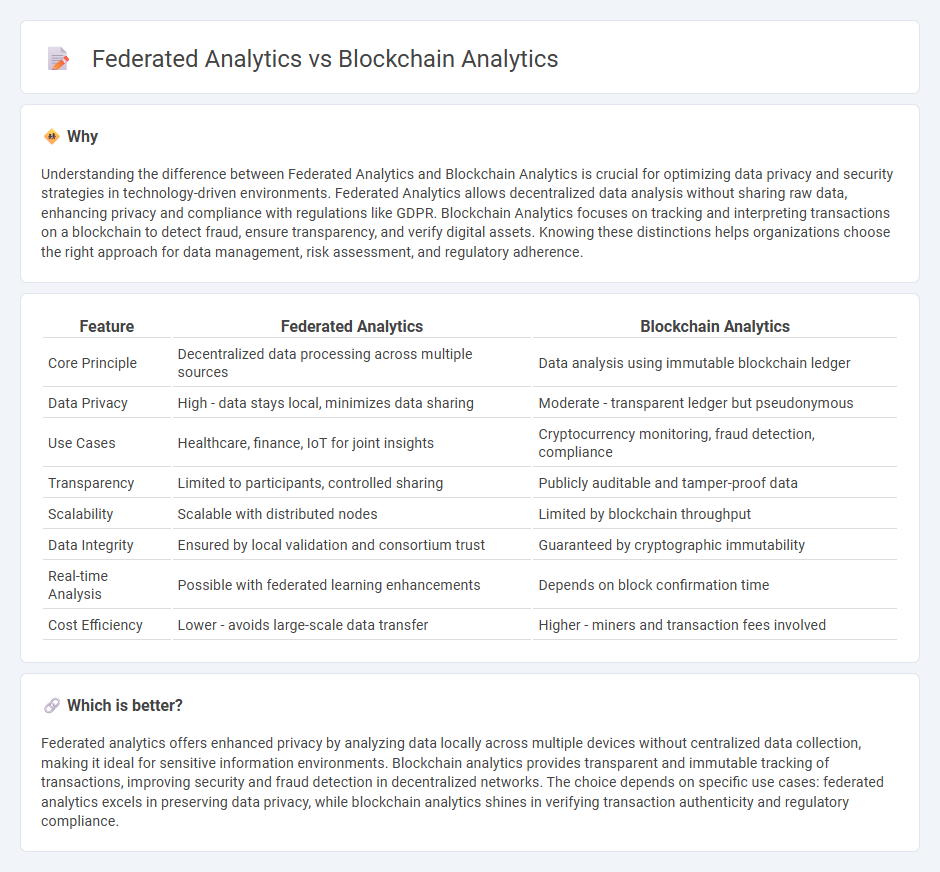
Federated analytics enables collaborative data analysis across multiple decentralized sources without sharing raw data, preserving privacy and enhancing security. Blockchain analytics involves examining transaction data on distributed ledgers to trace asset movements and identify fraudulent activities. Explore the distinctions and applications of federated and blockchain analytics to understand their impact on data privacy and security.
Why it is important
Understanding the difference between Federated Analytics and Blockchain Analytics is crucial for optimizing data privacy and security strategies in technology-driven environments. Federated Analytics allows decentralized data analysis without sharing raw data, enhancing privacy and compliance with regulations like GDPR. Blockchain Analytics focuses on tracking and interpreting transactions on a blockchain to detect fraud, ensure transparency, and verify digital assets. Knowing these distinctions helps organizations choose the right approach for data management, risk assessment, and regulatory adherence.
Comparison Table
| Feature | Federated Analytics | Blockchain Analytics |
|---|---|---|
| Core Principle | Decentralized data processing across multiple sources | Data analysis using immutable blockchain ledger |
| Data Privacy | High - data stays local, minimizes data sharing | Moderate - transparent ledger but pseudonymous |
| Use Cases | Healthcare, finance, IoT for joint insights | Cryptocurrency monitoring, fraud detection, compliance |
| Transparency | Limited to participants, controlled sharing | Publicly auditable and tamper-proof data |
| Scalability | Scalable with distributed nodes | Limited by blockchain throughput |
| Data Integrity | Ensured by local validation and consortium trust | Guaranteed by cryptographic immutability |
| Real-time Analysis | Possible with federated learning enhancements | Depends on block confirmation time |
| Cost Efficiency | Lower - avoids large-scale data transfer | Higher - miners and transaction fees involved |
Which is better?
Federated analytics offers enhanced privacy by analyzing data locally across multiple devices without centralized data collection, making it ideal for sensitive information environments. Blockchain analytics provides transparent and immutable tracking of transactions, improving security and fraud detection in decentralized networks. The choice depends on specific use cases: federated analytics excels in preserving data privacy, while blockchain analytics shines in verifying transaction authenticity and regulatory compliance.
Connection
Federated analytics and blockchain analytics intersect through their shared emphasis on data privacy and decentralized data processing. Federated analytics enables collaborative data insights without centralizing sensitive information, which complements blockchain analytics' use of transparent, immutable ledgers to trace transactions securely. This connection enhances data-driven decision-making by combining federated learning's privacy-preserving methods with blockchain's verifiable data integrity.
Key Terms
Decentralization
Blockchain analytics leverages decentralized ledger data to provide transparent and immutable transaction insights across various nodes without a central authority. Federated analytics enables collaborative data analysis across multiple decentralized parties while preserving data privacy by processing information locally and aggregating results. Explore how decentralization shapes these analytics approaches to enhance security and data sovereignty.
Privacy-preserving computation
Blockchain analytics leverages decentralized ledgers to provide transparent and immutable transaction data, enhancing auditability while posing privacy challenges due to public accessibility. Federated analytics enables collaborative data analysis across multiple parties without sharing raw data, employing privacy-preserving computation techniques like secure multiparty computation and differential privacy to safeguard sensitive information. Explore in-depth how these privacy-preserving computation methods balance data utility and confidentiality in blockchain and federated analytics contexts.
Data provenance
Blockchain analytics ensures data provenance by utilizing immutable ledgers that record every transaction, providing transparent and verifiable audit trails. Federated analytics enhances data provenance by enabling collaborative data analysis across decentralized sources without compromising the original data integrity or ownership. Explore the detailed mechanisms and benefits of these analytics approaches to understand their impact on data provenance in modern data ecosystems.
Source and External Links
Blockchain Analytics Explained: Overview, Uses, and How Does it Work - Blockchain analytics involves extracting patterns from public blockchain transactional data to identify and monitor illicit activity and compliance risks using behavior-based analytics and regulatory guidelines.
What is... Blockchain Analytics? - Elliptic - Blockchain analytics traces cryptocurrency transactions to their sources and destinations through data collection and analysis, often involving pattern recognition and machine learning to detect illicit activities.
What is Blockchain Analytics? - Google Cloud - Blockchain analytics provides indexed blockchain data via tools like BigQuery, enabling developers and analysts to easily query and analyze complete on-chain transaction histories without maintaining blockchain nodes or indexers.
 dowidth.com
dowidth.com